金柑属(Fortunella Swingle,1915)植物,别名金橘等,原产中国,为芸香科(Rutacease)柑橘亚科(Aurantioideae)柑橘族(Citreae)柑橘亚族(Citrinae)的一类植物。主要包括金豆(F.hindsii Swingle)、罗纹(F.japonica Swingle)、长叶金柑(F.polyandra Tanaka)、罗浮(F.margarita Swingle)4 个种和长寿金柑(F.obovata Tanaka)、金弹(F.crassifolia Swingle)2个杂交种[1],在广西融安、阳朔、湖南浏阳和蓝山等地广泛种植[2-3],食用价值和药用价值极高[4-9],国内外市场竞争力强[10-13],具有广阔的发展前景。
目前,果树育种主要采用杂交育种和芽变育种两个途径。据不完全统计,在中国的苹果、桃及梨等11 种果树中,约有63.9%的新品种是通过杂交育种获得的[14]。然而,柑橘类植物的育种仍以芽变育种为主,通过杂种选育得到的新品种仅占6.3%[15]。杂交育种可以从父母本获得优良性状,能够满足人们对培育果树新品种的需求,因此传统的人工杂交育种技术在培育新品种方面仍具有重要地位[16]。
在植物的杂交育种中,花粉是遗传物质传递的中间媒介[17],掌握花粉的生物学特性可以有效提高授粉成功率,对选择合适的杂交亲本意义重大[18],而柱头的可授性则直接影响到受精能否继续进行[19]。因此,研究花粉柱头活性,选择优良的杂交亲本,可以有效提高结实率,有助于培育杂交新品种[20]。近年来,学者们对花粉活力和柱头可授性等的研究越发深入,为杂交育种提供了坚实的理论支持;Liu等[21]以拟南芥为研究对象,揭示了花粉-柱头保守的识别机制,这对克服远缘杂交障碍、获得优良性状的品种具有重要意义;朱江华等[22]通过对比研究6 个蓝莓品种的花粉量、花粉活力及花粉萌发率等花粉特性,发现花粉量大、萌发率高、花粉活力好的品种在授粉过程中表现出特殊的优异性。
笔者在本研究中通过比较不同时期的花粉活力与柱头可授性,确定最佳授粉时期。对金柑进行去雄不授粉、自交授粉和杂交授粉三种处理并比较自交授粉和杂交授粉的花粉管的生长情况及三种处理下的坐果率,初步探明金柑杂交授粉的生物学特性,为金柑杂交育种提供一定的理论依据。
1 材料和方法
1.1 试验材料
试验材料采自湖南农业大学金山金柑资源圃,其中,金弹种15 份材料,罗纹种3 份材料,罗浮种2份材料,山金柑种2 份材料和长寿金柑种1 份材料,共计23份材料(表1)。
表1 试验供试材料
Table 1 Test materials
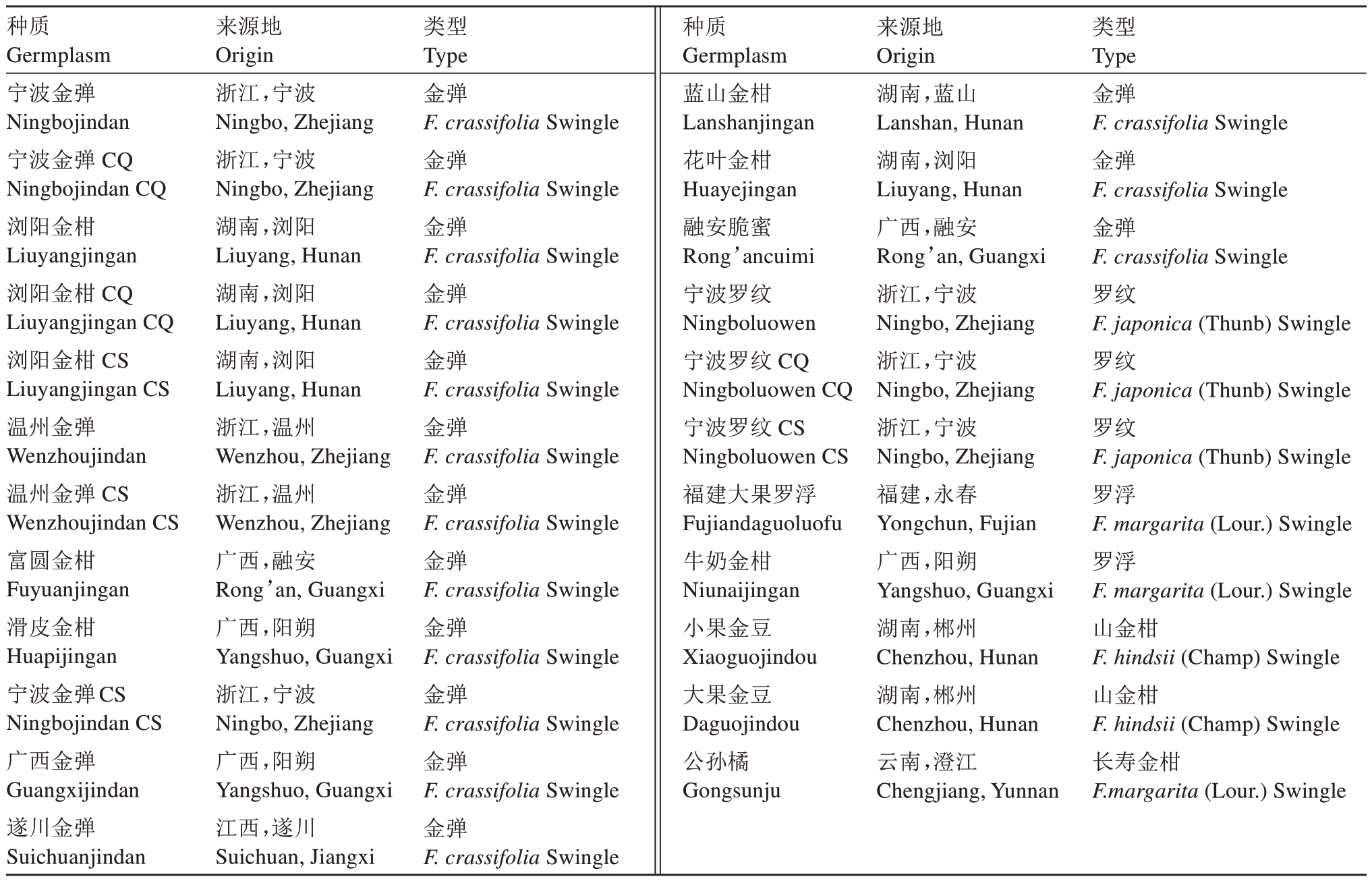
注:CQ 表示引种于中国农业科学院柑橘研究所(重庆);CS 表示引种于湖南省园艺研究所(长沙)。
Note: CQ means introduced from Citrus Research Institute of Chinese Academy of Agricultural Sciences (In Chongqing); CS means introduced in Hunan Horticultural Research Institute(In Changsha).
种质Germplasm宁波金弹Ningbojindan宁波金弹CQ Ningbojindan CQ浏阳金柑Liuyangjingan浏阳金柑CQ Liuyangjingan CQ浏阳金柑CS Liuyangjingan CS温州金弹Wenzhoujindan温州金弹CS Wenzhoujindan CS富圆金柑Fuyuanjingan滑皮金柑Huapijingan宁波金弹CS Ningbojindan CS广西金弹Guangxijindan遂川金弹Suichuanjindan来源地Origin浙江,宁波Ningbo,Zhejiang浙江,宁波Ningbo,Zhejiang湖南,浏阳Liuyang,Hunan湖南,浏阳Liuyang,Hunan湖南,浏阳Liuyang,Hunan浙江,温州Wenzhou,Zhejiang浙江,温州Wenzhou,Zhejiang广西,融安Rong’an,Guangxi广西,阳朔Yangshuo,Guangxi浙江,宁波Ningbo,Zhejiang广西,阳朔Yangshuo,Guangxi江西,遂川Suichuan,Jiangxi类型Type金弹F.crassifolia Swingle金弹F.crassifolia Swingle金弹F.crassifolia Swingle金弹F.crassifolia Swingle金弹F.crassifolia Swingle金弹F.crassifolia Swingle金弹F.crassifolia Swingle金弹F.crassifolia Swingle金弹F.crassifolia Swingle金弹F.crassifolia Swingle金弹F.crassifolia Swingle金弹F.crassifolia Swingle种质Germplasm蓝山金柑Lanshanjingan花叶金柑Huayejingan融安脆蜜Rong’ancuimi宁波罗纹Ningboluowen宁波罗纹CQ Ningboluowen CQ宁波罗纹CS Ningboluowen CS福建大果罗浮Fujiandaguoluofu牛奶金柑Niunaijingan小果金豆Xiaoguojindou大果金豆Daguojindou公孙橘Gongsunju来源地Origin湖南,蓝山Lanshan,Hunan湖南,浏阳Liuyang,Hunan广西,融安Rong’an,Guangxi浙江,宁波Ningbo,Zhejiang浙江,宁波Ningbo,Zhejiang浙江,宁波Ningbo,Zhejiang福建,永春Yongchun,Fujian广西,阳朔Yangshuo,Guangxi湖南,郴州Chenzhou,Hunan湖南,郴州Chenzhou,Hunan云南,澄江Chengjiang,Yunnan类型Type金弹F.crassifolia Swingle金弹F.crassifolia Swingle金弹F.crassifolia Swingle罗纹F.japonica(Thunb)Swingle罗纹F.japonica(Thunb)Swingle罗纹F.japonica(Thunb)Swingle罗浮F.margarita(Lour.)Swingle罗浮F.margarita(Lour.)Swingle山金柑F.hindsii(Champ)Swingle山金柑F.hindsii(Champ)Swingle长寿金柑F.margarita(Lour.)Swingle
1.2 试验方法
试验于2020 年6—8 月在金山基地进行。并将金柑开花动态分为以下4 个时期[23],每个时期对应的花蕾形态如图1。
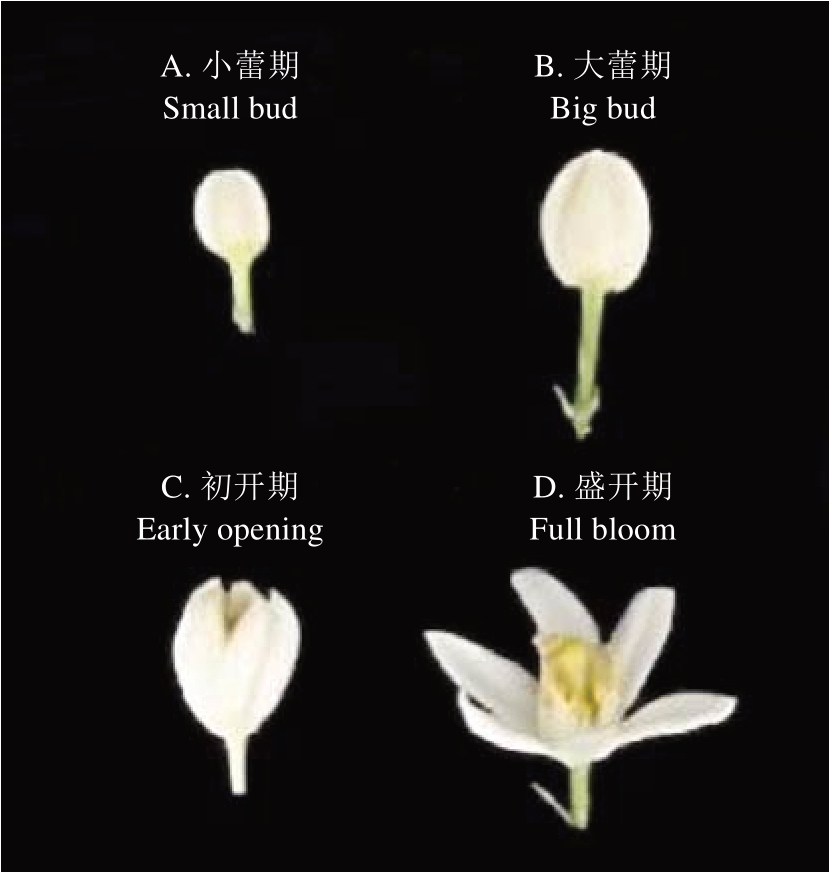
图1 金柑花蕾的四种形态
Fig.1 Four forms of Fortunella flower buds
1.2.1 自然授粉果实胚数统计 在自然授粉结实条件下,从23 份种质资源成熟果实中取出种子,去除种皮,将子叶分开观察胚数,每种材料至少5 个果实,计算种子数与胚数的平均值。按照胚数从少到多分别选择罗纹种的宁波罗纹、宁波罗纹CQ 和宁波罗纹CS,金弹种的宁波金弹、宁波金弹CQ、浏阳金柑CQ、温州金弹CS、蓝山金柑和浏阳金柑,罗浮种的牛奶金柑用于后续试验。
1.2.2 花粉活力的测定 参照0.5%TTC 染色法[24]并略作修改,分别在金柑花蕾的小蕾期、大蕾期、初开期和盛开期4 个时期,各采集10 个花蕾样本。取花药置于载玻片上,滴加1~2 滴0.5%TTC 溶液(2,3,5-uiphenyl tetrazolium chloride),置于湿润的培养皿中,室温下静置30~45 min,在显微镜视野中随机选择5 个不同的位置,统计总花粉粒数和变色花粉粒数(包括红色和粉色)。按照公式1计算花粉活力。

1.2.3 柱头活性的测定 参照联苯胺-过氧化氢法[25],分别在金柑花蕾的小蕾期、大蕾期、初开期和盛开期4个时期,各采集10个花蕾样本,单独取柱头于卡诺式固定液中固定,取出柱头,浸入滴有联苯胺-过氧化氢溶液的凹面载玻片中,室温静置10 min后在显微镜下观察柱头周围的气泡产生及颜色变化情况。柱头可授性检测标准参照焦雪辉等[24]的方法(表2)。
表2 柱头可授性检测标准
Table 2 Acceptability test standard of stigma
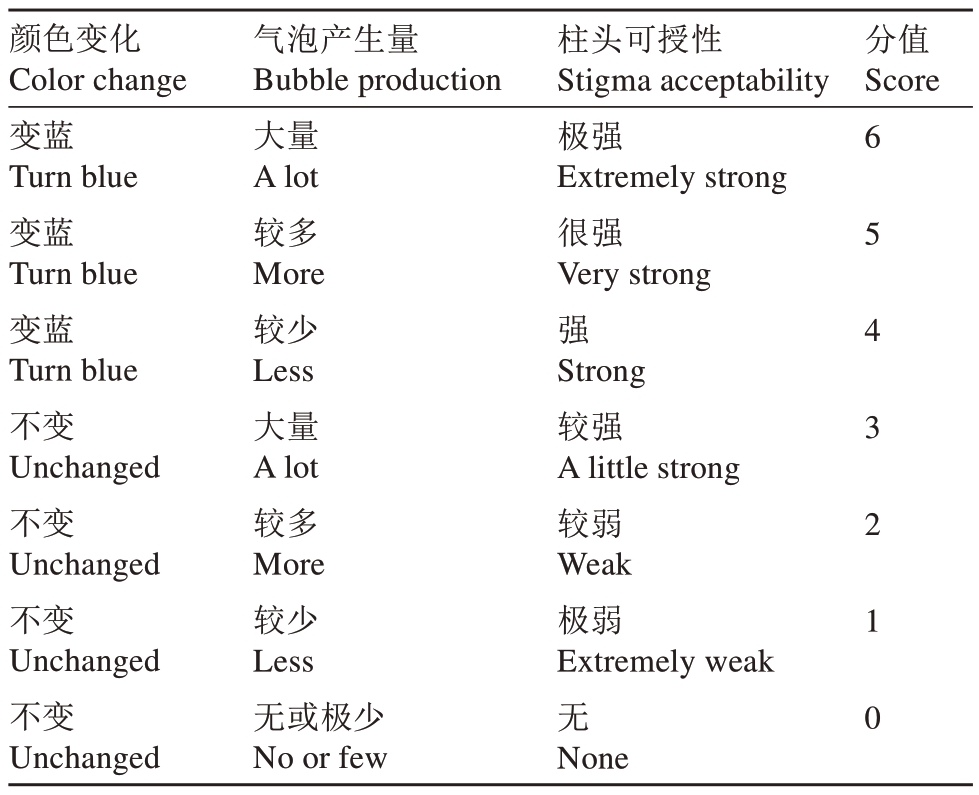
颜色变化Color change变蓝Turn blue变蓝Turn blue变蓝Turn blue不变Unchanged不变Unchanged不变Unchanged不变Unchanged气泡产生量Bubble production大量A lot较多More较少Less大量A lot较多More较少Less无或极少No or few柱头可授性Stigma acceptability极强Extremely strong很强Very strong强Strong较强A little strong较弱Weak极弱Extremely weak无None分值Score 6 5 4 3 2 1 0
1.2.4 花粉的采集与授粉 基于花粉活力与柱头可授性的试验结果,选定宁波金弹、浏阳金柑CQ、宁波罗纹、宁波罗纹CQ、蓝山金柑、宁波罗纹CS、牛奶金柑及温州金弹CS,共计8 种材料为杂交亲本。自交及杂交组合情况详见表3。
表3 金柑自交及杂交组合
Table 3 Self-pollination and Cross-breeding Combinations of Kumquats
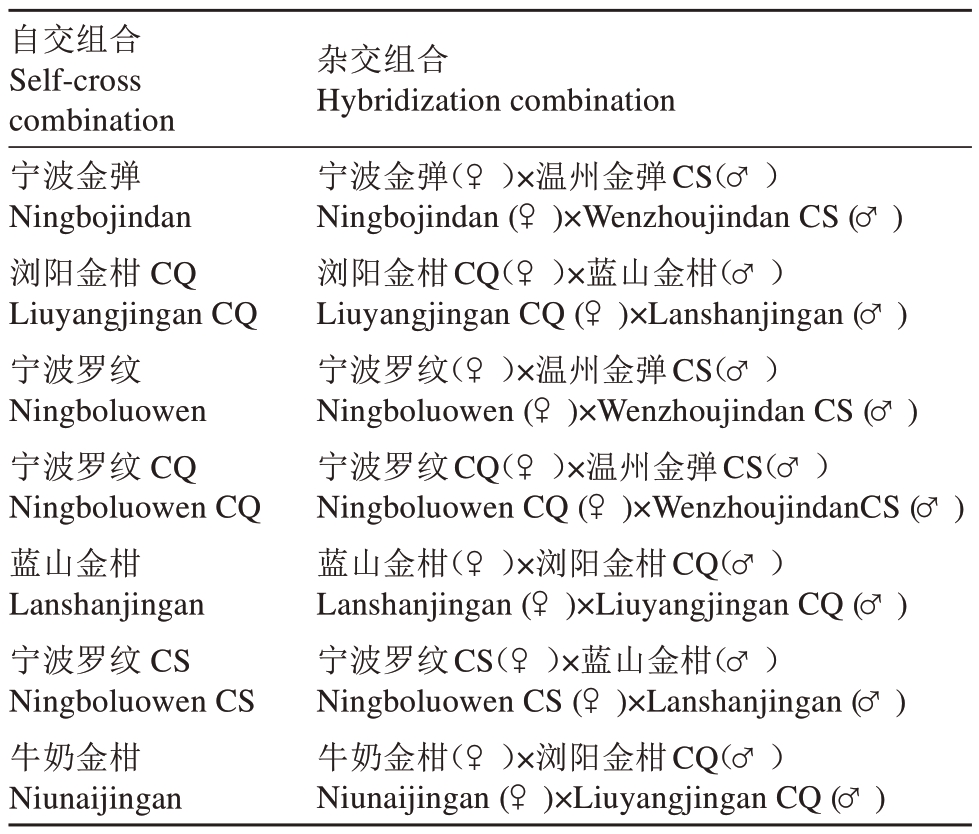
自交组合Self-cross combination宁波金弹Ningbojindan浏阳金柑CQ Liuyangjingan CQ宁波罗纹Ningboluowen宁波罗纹CQ Ningboluowen CQ蓝山金柑Lanshanjingan宁波罗纹CS Ningboluowen CS牛奶金柑Niunaijingan杂交组合Hybridization combination宁波金弹(♀)×温州金弹CS(♂)Ningbojindan(♀)×Wenzhoujindan CS(♂)浏阳金柑CQ(♀)×蓝山金柑(♂)Liuyangjingan CQ(♀)×Lanshanjingan(♂)宁波罗纹(♀)×温州金弹CS(♂)Ningboluowen(♀)×Wenzhoujindan CS(♂)宁波罗纹CQ(♀)×温州金弹CS(♂)Ningboluowen CQ(♀)×WenzhoujindanCS(♂)蓝山金柑(♀)×浏阳金柑CQ(♂)Lanshanjingan(♀)×Liuyangjingan CQ(♂)宁波罗纹CS(♀)×蓝山金柑(♂)Ningboluowen CS(♀)×Lanshanjingan(♂)牛奶金柑(♀)×浏阳金柑CQ(♂)Niunaijingan(♀)×Liuyangjingan CQ(♂)
每天早晨07:00—08:30 采集父本花蕾接近初开期之前的雄蕊。取花药并在干燥器中干燥至其花粉散落,4 ℃冰箱中保存备用。
每天上午07:00—09:00进行授粉。
(1)去雄不授粉:去除母本花蕾接近初开期之前的雄蕊,套上硫酸纸袋并记录去雄时间,3 d 后取下硫酸袋,10 d后统计坐果率。
(2)自交授粉:授粉前1 d 下午18:00,去除目标材料花瓣和雄蕊,套上硫酸袋。第2 天早上07:00,用毛刷进行人工授粉。授粉时,用毛笔刷轻轻地将花粉刷在柱头上,直到柱头表面明显观察到黄色花粉,确保授粉成功。每朵花连续3 d在相同时间授粉3次,从第3天授粉完成后开始计算,3 d后去袋,10 d后统计坐果率。
(3)杂交授粉:按照表3 的杂交组合,将处理好的父本花粉涂抹在选定的母本柱头上,其他操作与自交授粉相同。
1.2.5 花粉管生长观察 在大蕾期,按照表3 所示的自交与杂交组合分别进行授粉处理,授粉方法与1.2.4 节相同,在授粉结束后的2、4、8、12、24、48 h 分别取10 个花柱从子房基部切除,于卡诺式固定液中固定12~24 h。之后分别经过70%乙醇、50%乙醇、30%乙醇及蒸馏水冲洗后,放于2 mol·L-1的NaOH溶液中软化8~12 h。最后在0.1%水溶性苯胺蓝中染色12~24 h,用解剖刀切开柱头并压片,在荧光显微镜下观察花粉管生长情况并拍照。
1.2.6 坐果率的统计 统计各种处理下的授粉花朵数,并在授粉完成后的第10 天统计坐果数,按照公式2计算坐果率。
1.2.7 数据处理与分析 本试验数据通过Excel 进行记录、统计,采用SPSS 26.0 进行方差分析,用Origin 2018进行图表绘制。
2 结果与分析
2.1 金柑种质资源胚数分析
23 份种质的种子数及胚数统计结果如表4,罗纹种胚数均为1个,为单胚型种质,最适合做母本;其次为山金柑、金弹和罗浮,胚数最多的为长寿金柑。
表4 单果种子数及胚数统计
Table 4 Statistics of the number of seeds and embryos of a single fruit
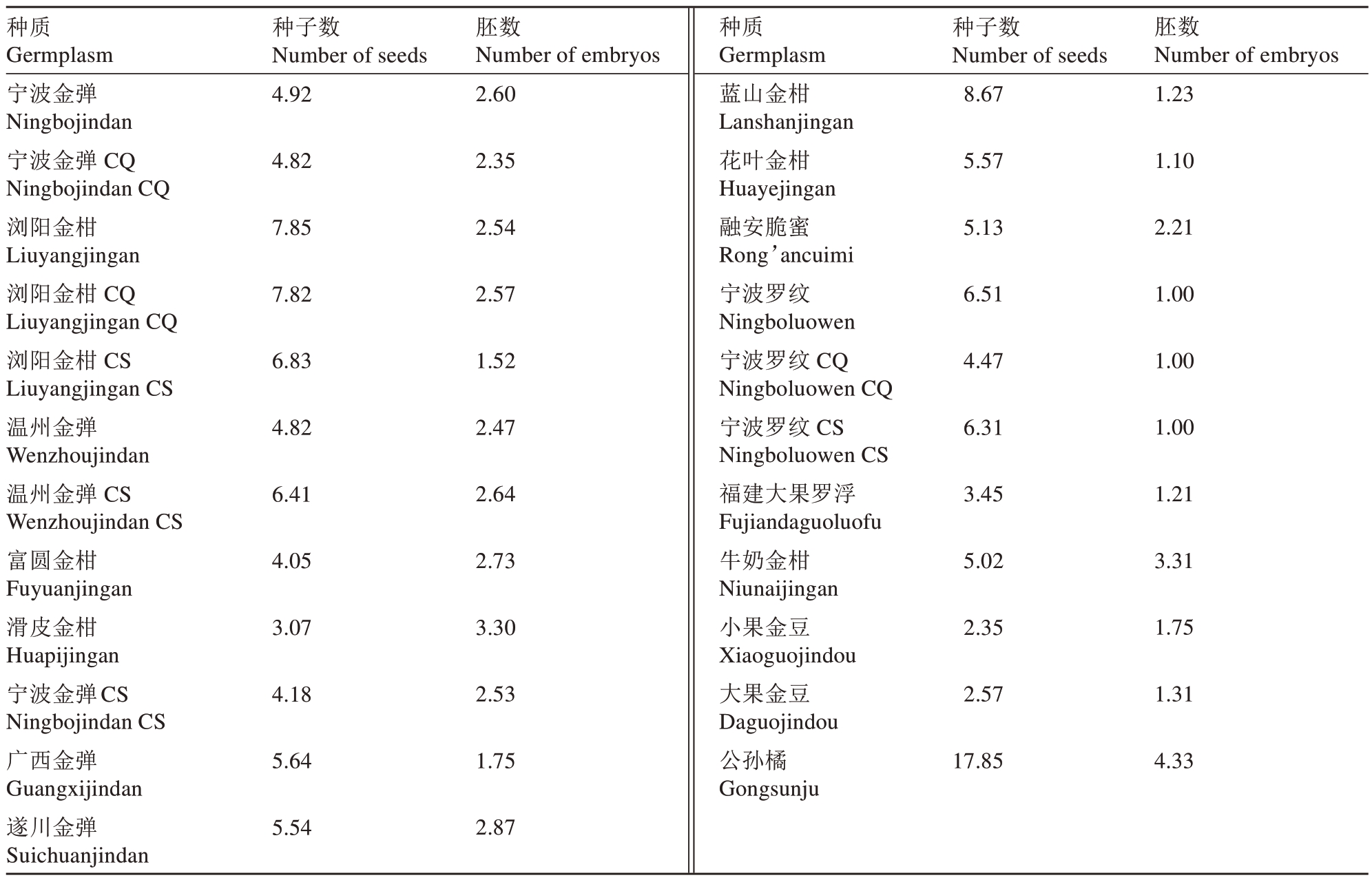
种质Germplasm宁波金弹Ningbojindan宁波金弹CQ Ningbojindan CQ浏阳金柑Liuyangjingan浏阳金柑CQ Liuyangjingan CQ浏阳金柑CS Liuyangjingan CS温州金弹Wenzhoujindan温州金弹CS Wenzhoujindan CS富圆金柑Fuyuanjingan滑皮金柑Huapijingan宁波金弹CS Ningbojindan CS广西金弹Guangxijindan遂川金弹Suichuanjindan种子数Number of seeds 4.92胚数Number of embryos 2.60种子数Number of seeds 8.67胚数Number of embryos 1.23 4.82 2.35 5.57 1.10 7.85 2.54 5.13 2.21 7.82 2.57 6.51 1.00 6.83 1.52 4.47 1.00 4.82 2.47 6.31 1.00 6.41 2.64 3.45 1.21 4.05 2.73 5.02 3.31 3.07 3.30 2.35 1.75 4.18 2.53 2.57 1.31 5.64 1.75种质Germplasm蓝山金柑Lanshanjingan花叶金柑Huayejingan融安脆蜜Rong’ancuimi宁波罗纹Ningboluowen宁波罗纹CQ Ningboluowen CQ宁波罗纹CS Ningboluowen CS福建大果罗浮Fujiandaguoluofu牛奶金柑Niunaijingan小果金豆Xiaoguojindou大果金豆Daguojindou公孙橘Gongsunju 17.85 4.33 5.54 2.87
2.2 金柑不同时期花粉活力比较
不同金柑花蕾在4 个时期的花粉活力均呈现先升后降的趋势,并在初开期达到了最强水平(图2)。相同时期下,蓝山金柑的花粉活力最强,与除温州金弹CS 以外的其他金柑种质存在显著差异(p<0.05)。在大蕾期,宁波金弹、温州金弹CS 和浏阳金柑CQ 间不存在显著性差异(p>0.05),且该3 种金柑与蓝山金柑、宁波罗纹CQ 和浏阳金柑呈显著性差异(p<0.05)。
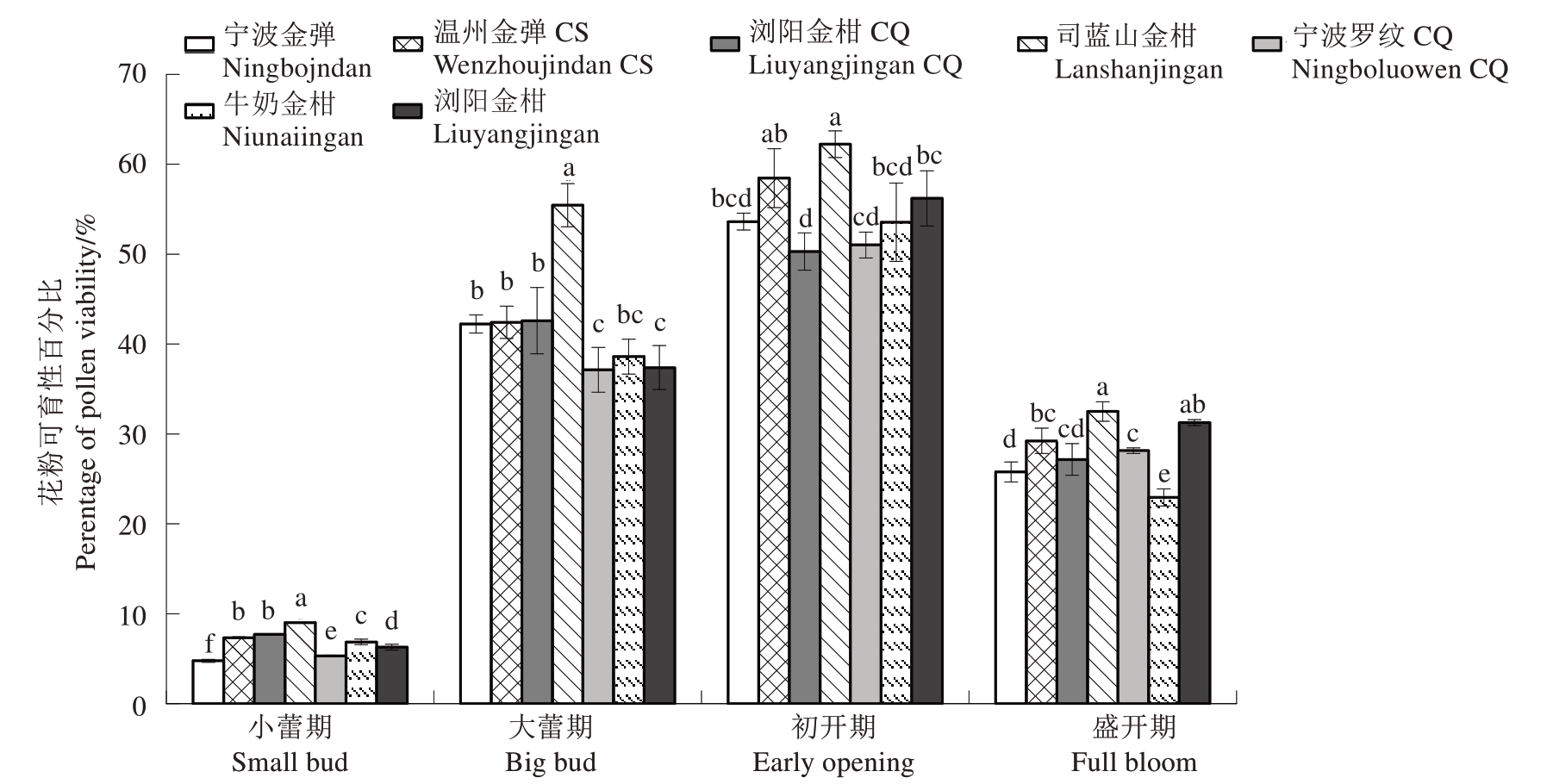
图2 金柑不同时期花粉活力测定
Fig.2 Determination of pollen viability in kumquat at different times
误差线为标准误,不同小写字母表示不同类型材料在相同时期花粉活力的差异显著(p<0.05)。下同。
The error bars are standard errors,and different small letters indicate significant differences in pollen viability of different types of materials at the same time(p<0.05).The same below.
杂交中为避免串粉现象,选择接近初开期的大蕾期为采集花粉的时期。在大蕾期,金柑花粉活力从高到低分别为蓝山金柑>浏阳金柑CQ>温州金弹CS>宁波金弹>牛奶金柑>宁波罗纹CQ>浏阳金柑。选择花粉活力较强的种质作为杂交授粉的父本,即蓝山金柑、浏阳金柑CQ、温州金弹CS。
2.3 金柑不同时期柱头可授性比较
不同金柑花蕾在4 个时期的柱头可授性均呈现先增强后减弱的趋势,并在初开期达到了最高水平(图3)。在大蕾期时,蓝山金柑的柱头可授性高于其他金柑并存在显著性差异(p<0.05),除蓝山金柑外的其他7种金柑间不存在显著性差异(p>0.05)。
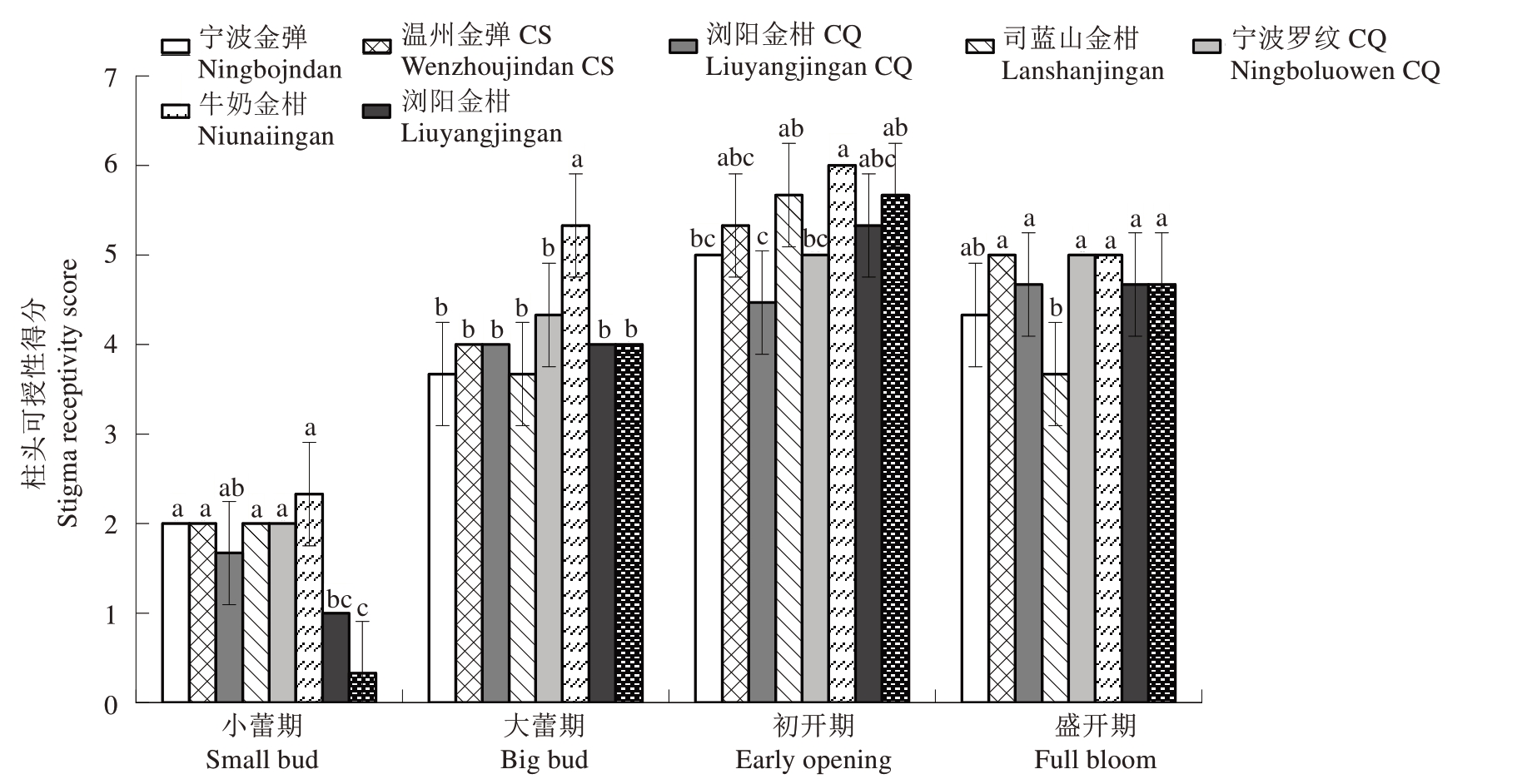
图3 金柑不同时期柱头可授性测定
Fig.3 Determination of stigma pollinability in kumquat at different times
柱头可授性的强弱会直接影响花粉在柱头上的萌发概率,柱头可授性越强,接受花粉的能力越强,从而更容易完成受精过程。通过对金柑4 个时期柱头活性的检测,发现金柑在初开期普遍表现出最强的柱头可授性。所测材料均适用作人工杂交授粉的母本材料。然而,为了避免串粉现象,应在接近初开期之前去除雄蕊并授粉。
2.4 金柑自交与杂交花粉管生长比较
通过对自交和杂交的花粉管进行观察和比较,发现所有的自交和杂交花粉管在授粉后2 h 左右开始萌发(图4-A、B);授粉4~8 h 时,杂交花粉管的生长长度达到了花柱总长的1/3~1/2,而自交花粉管生长速度相对较慢;授粉12~24 h 时,大多数杂交花粉管已经延伸到了花柱基部(图4-C),一些自交花粉管在花柱总长的2/3 处停止了伸长(图4-D)。授粉48 h 后,所有杂交花粉管和部分自交花粉管穿过花柱基部,进入子房内部(图4-E、F),宁波金弹、宁波罗纹CS及牛奶金柑等自交组合中,花粉管生长缓慢甚至停止。上述结果表明金柑种质具有完全杂交亲和性,且存在部分自交不亲和现象。
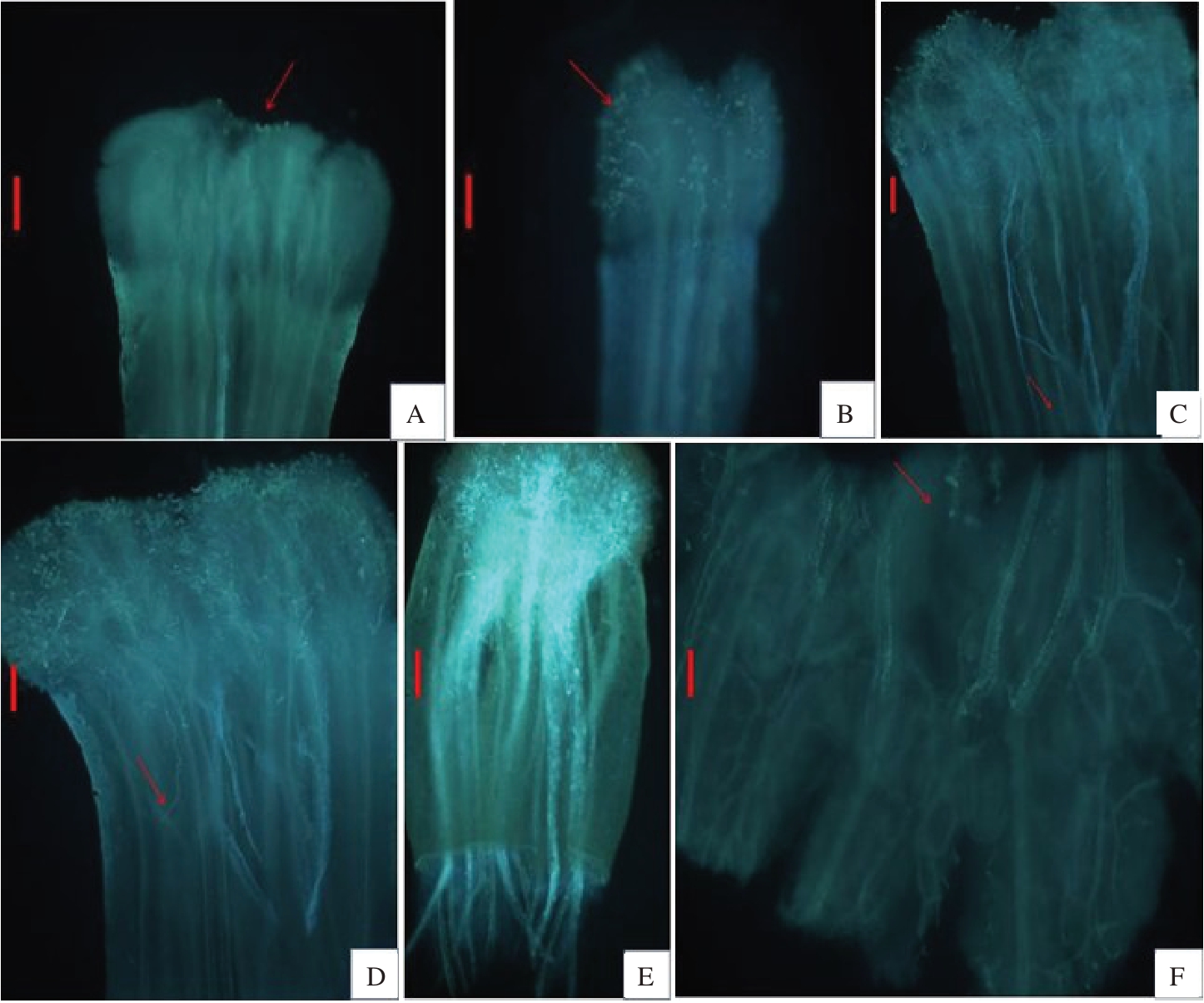
图4 金柑自交和杂交花粉管生长比较
Fig.4 Comparison of self-crossed and hybrid pollen tube growth of kumquat
A.自交2 h 花粉管生长状;B.杂交2 h 花粉管生长状;C.杂交24 h 花粉管生长状;D.自交24 h 花粉管生长状;E.杂交48 h 花粉管生长状;F.花粉管进入子房。
A.Self-inbred 2 h pollen tube growth state; B.Hybrid 2 h pollen tube growth state; C.Pollen tube growth state in 24 h hybridization; D.Self-inbred 24 h pollen tube growth state;E.Hybrid 48 h pollen tube growth state;F.Pollen tube into the ovary.
2.5 不同处理条件下坐果率的比较
在去雄不授粉条件下,7 份金柑种质均得到了果实,说明金柑子房在未授粉的情况下也能发育成为果实,具有单性结实的特性;在人工自交授粉处理条件下,蓝山金柑的坐果率最高,并与其他金柑种质间呈现出显著性差异;在杂交授粉处理条件下,浏阳金柑CQ 的坐果率最高,其次为蓝山金柑,该2种金柑种质间不存在显著性差异,但与其他5种金柑种质存在显著性差异(图5)。在人工自交授粉、去雄不授粉和杂交授粉三种处理条件下,蓝山金柑得到了较高的坐果率,与蓝山金柑花粉活性和柱头可授性均最高有关。
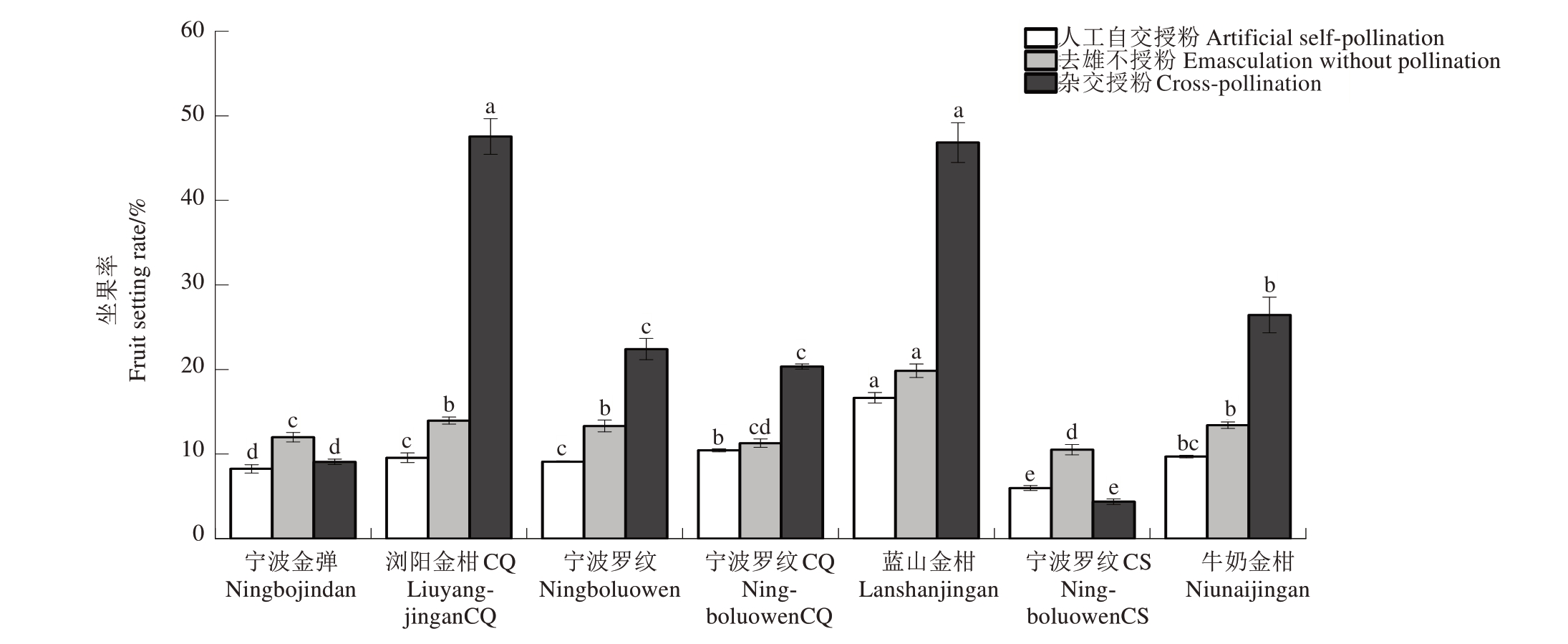
图5 不同金柑种质的坐果率统计比较
Fig.5 Statistical comparison of fruit setting rate of different kumquat germplasms
同一母本材料在人工自交授粉处理及杂交授粉处理下的坐果率差异性分析如表5,发现除宁波金弹和宁波罗纹CS外,其他5种金柑种质在两种不同处理条件下的坐果率呈现出极显著性差异,且杂交授粉比自交授粉的坐果率更高,说明金柑种质的杂交亲和性比自交亲和性更强,有利于金柑的杂交育种。上述结果与2.4花粉管生长的试验结果相同。
表5 人工自交授粉与杂交授粉的金柑坐果率差异性分析
Table 5 Differential analysis of fruit setting rate of kumquat between artificial self-pollination and crosspollination
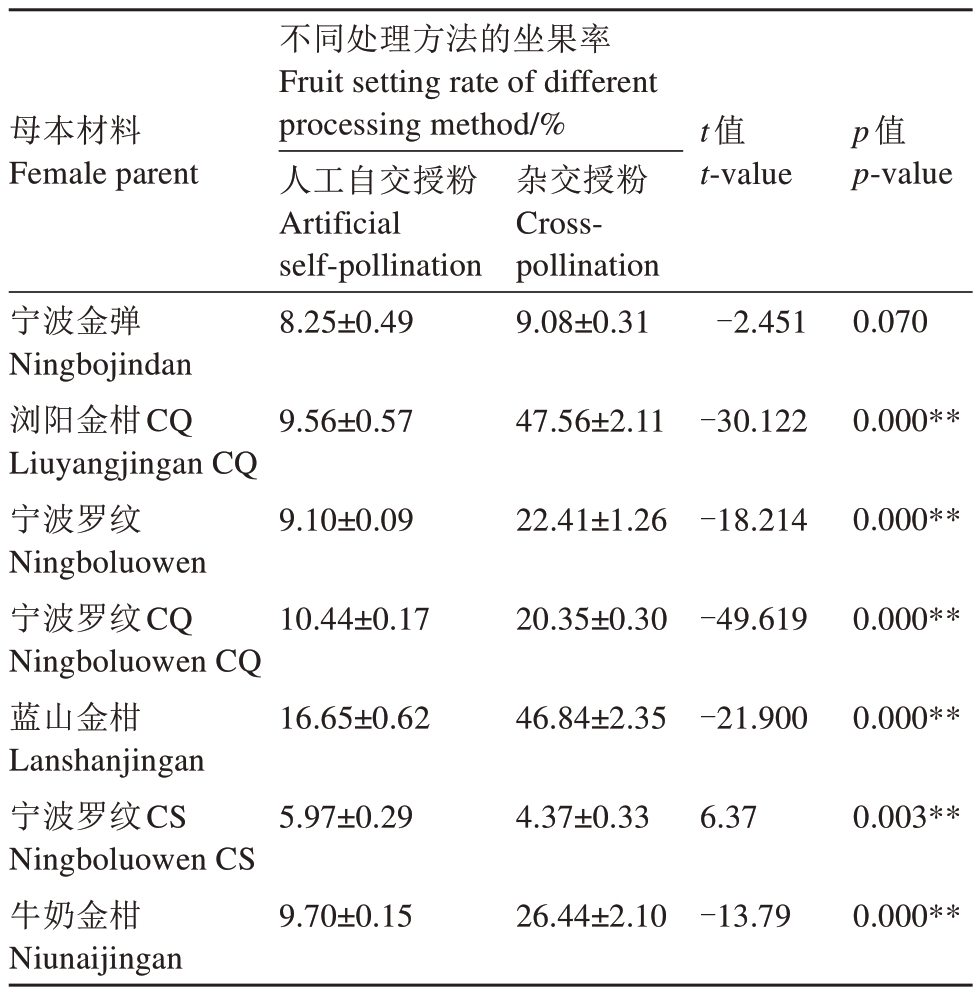
注:**表示极显著(p≤0.01)。下同。
Note:**indicates highly significant(p≤0.01).The same below.
母本材料Female parent t值t-value p值p-value宁波金弹Ningbojindan浏阳金柑CQ Liuyangjingan CQ宁波罗纹Ningboluowen宁波罗纹CQ Ningboluowen CQ蓝山金柑Lanshanjingan宁波罗纹CS Ningboluowen CS牛奶金柑Niunaijingan Fruit setting rate of different processing method/%人工自交授粉Artificial self-pollination 8.25±0.49杂交授粉Crosspollination 9.08±0.31-2.451 0.070 9.56±0.57 47.56±2.11-30.122 0.000**9.10±0.09 22.41±1.26-18.214 0.000**10.44±0.17 20.35±0.30-49.619 0.000**16.65±0.62 46.84±2.35-21.900 0.000**5.97±0.29 4.37±0.33 6.37 0.003**9.70±0.15 26.44±2.10-13.79 0.000**
2.6 金柑杂交授粉的坐果率差异性分析
在杂交授粉处理条件下,同一父本不同母本间坐果率的差异情况如表6 所示。父本材料为温州金弹CS时,母本材料为宁波金弹与宁波罗纹坐果率呈现出极显著性差异,柱头活性高的宁波罗纹坐果率更高;母本材料宁波金弹与宁波罗纹CQ 坐果率呈现出极显著性差异;宁波罗纹和宁波罗纹CQ 间坐果率差异并不显著,但宁波罗纹的柱头活性更强,坐果率更高;父本材料为蓝山金柑时,母本材料为宁波罗纹CS 与浏阳金柑CQ 的坐果率存在极显著性差异,尽管宁波罗纹CS 的柱头活性更高,但坐果率却更低,说明种间杂交亲和性更差;父本材料为浏阳金柑CQ时,母本材料牛奶金柑和蓝山金柑的坐果率间存在极显著性差异,蓝山金柑柱头活性更强,且种内杂交亲和性更强,因而其坐果率更高。综上所述,柱头活性越高,坐果率越高,且种内杂交的坐果率高于种间杂交。因此在选择杂交亲本时,应考虑柱头活性和亲本亲缘关系等因素。
表6 金柑不同杂交组合间坐果率差异性分析
Table 6 Variability analysis of fruit setting rate among different hybrid combinations of kumquat
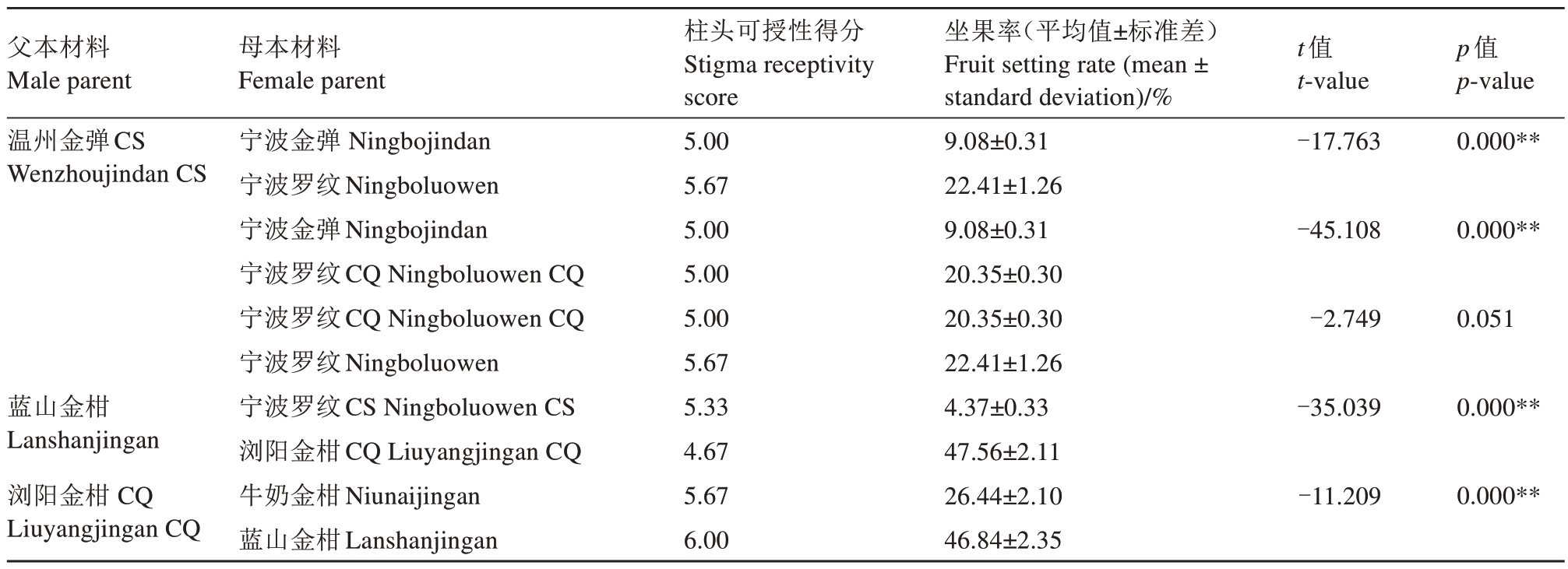
父本材料Male parent温州金弹CS Wenzhoujindan CS坐果率(平均值±标准差)Fruit setting rate(mean±standard deviation)/%t值t-value-17.763 p值p-value 0.000**母本材料Female parent宁波金弹Ningbojindan宁波罗纹Ningboluowen宁波金弹Ningbojindan宁波罗纹CQ Ningboluowen CQ宁波罗纹CQ Ningboluowen CQ宁波罗纹Ningboluowen宁波罗纹CS Ningboluowen CS浏阳金柑CQ Liuyangjingan CQ牛奶金柑Niunaijingan蓝山金柑Lanshanjingan柱头可授性得分Stigma receptivity score 5.00 5.67 5.00 5.00 5.00 5.67 5.33 4.67 5.67 6.00 0.000**9.08±0.31 22.41±1.26 9.08±0.31 20.35±0.30 20.35±0.30 22.41±1.26 4.37±0.33 47.56±2.11 26.44±2.10 46.84±2.35-45.108-2.749 0.051蓝山金柑Lanshanjingan浏阳金柑CQ Liuyangjingan CQ-35.039 0.000**-11.209 0.000**
3 讨 论
了解植物授粉生物学特性对植物杂交育种具有重要的指导意义[20,25-27]。对于柑橘类植物的杂交育种来说,经常由于珠心胚的干扰而不能获得杂种,其原因是珠心胚与合子胚之间存在竞争关系,导致合子胚发育失败[28]。但当以单胚为母本时可以提高柑橘类植物的杂种率,因此笔者在本研究中比较了不同金柑种质的胚数,以筛选出单胚种质,作为杂交的母本材料。笔者在本研究中发现罗纹种为单胚种质,适合作为杂交母本。
柱头可授性和花粉活性也是影响杂交成功率的重要因素。通过比较不同时期金柑花蕾的柱头可授性和花粉活性,结果显示二者的活性趋势相似,且均在初开期达到最强,属于雌雄同熟植物,并未发现花粉败育情况[29]。试验结果与百香果和樱桃相同[30-31]。但是在杂交实践中,为了避免串粉,通常在初开期之前的大蕾期进行花粉采集和去雄处理。
被子植物受精过程主要包括花粉与柱头的识别、花粉管在花柱间的伸长,以及雌雄配子间的融合三个阶段,任意阶段无法识别均会导致杂交失败[32]。在授粉后2 h内为花粉与柱头识别的重要时间段[33],笔者在本研究中发现,金柑在授粉处理2 h 后,所有自交和杂交均完成了花粉与柱头的识别,花粉管开始在花柱内生长。在授粉48 h 后,所有杂交花粉管和部分自交花粉管穿过花柱基部进入子房。在花粉管的行为上表现出了较好的杂交亲和性,该现象在多种植物中被发现[34-35]。在本研究中,自交花粉管在花柱内停滞生长,表现出自交不亲和的现象,同样被雷翠云[36]发现。在花粉管生长阶段导致果树自交不亲和的因素有很多[37],目前对金柑中花粉管生长停滞现象的原因尚未见报道。在柑橘类植物中,被证实S-RNase 基因的表达调控[38]和信号传导[39]均会对花粉管的发育产生影响。其他原因如花粉管的导向生长[40]、微丝、微管骨架[41]等也会导致花粉管的生长停滞。
坐果率能直接反映出种质间亲和性的强弱,是研究种质间杂交及自交亲和性的重要指标之一[42-44]。笔者在本研究中发现,大部分金柑杂交的坐果率高于自交,并呈现极显著差异,该现象的原因可能是金柑具有杂交亲和性以及部分自交不亲和性,并且与花粉管的生长观察试验结果相同。该现象已在植物中被发现,如梨树[45]、甜菊[46]、枣[47]等。并且笔者在本研究中还发现,对金柑进行去雄不授粉处理后,子房仍可以发育成果实,表明金柑具有单性结实的特性,与雷翠云[36]的研究结果相同。
植物柱头的可授性强弱可以直接影响坐果率的高低,也是决定杂交育种工作成功与否的重要指标之一[48-49]。笔者在本研究中发现柱头活性越强,坐果率越高,且种内杂交的坐果率高于种间杂交。相关研究也表明,柱头可授性与坐果率间存在显著正相关[26,50]。因此在选择杂交亲本时,应考虑柱头活性和亲本亲缘关系等因素。以上对金柑杂交的生物学特性研究,为金柑杂交条件的确定以及杂交亲本的选择提供了一定的参考依据。
4 结 论
金柑杂交中应选择单胚型母本材料;金柑属于雌雄同熟果树,采集花粉最佳时期和授粉最佳时期均为初开期;金柑杂交亲和性比自交亲和性更强,有利于金柑的杂交育种。
[1] 曾勉.对柑桔分类的认识体会和整理的意见[J].中国果树,1960(2):31-37.ZENG Mian.Opinions on the cognition and collation of Citrus classification[J].China Fruits,1960(2):31-37.
[2] 郭鹏妹,秦艳,赵希娟,焦必宁.金柑果实主要次生代谢产物含量及差异分析[J].食品与发酵工业,2021,47(9):32-41.GUO Pengmei,QIN Yan,ZHAO Xijuan,JIAO Bining.Research on the contents and difference of the main secondary metabolites in different kumquat fruits[J].Food and Fermentation Industries,2021,47(9):32-41.
[3] 郑洁.我国不同品种金柑主要营养及功能成分研究[D].重庆:西南大学,2015.ZHENG Jie.Nutritional and functional compounds of major varieties of kumquat (Fortunella Swingle) in China[D].Chongqing:Southwest University,2015.
[4] ZENG H L,CHEN P L,CHANG Q,ZHENG B D,ZHANG Y.Hypolipidemic effect of polysaccharides from Fortunella mar‐garita (Lour.) Swingle in hyperlipidemic rats[J].Food and Chemical Toxicology,2019,132:110663.
[5] GANDHI G R,VASCONCELOS A B S,WU D T,LI H B,ANTONY P J,LI H,GENG F,GURGEL R Q,NARAIN N,GAN R Y.Citrus flavonoids as promising phytochemicals targeting diabetes and related complications:A systematic review of in vitro and in vivo studies[J].Nutrients,2020,12(10):2907.
[6] 黄华花,陈景海,徐晶晶,王圣江,林亚珠.金橘不同提取物对小鼠胃排空和小肠推进功能的影响[J].食品与药品,2019,21(3):179-182.HUANG Huahua,CHEN Jinghai,XU Jingjing,WANG Shengjiang,LIN Yazhu.Effect of different extracts from Fortunella margarita(Lour.)Swingle on gastric emptying and small intestinal propulsion in mice[J].Food and Drug,2019,21(3):179-182.
[7] OSHIMA T,TAKAHASHI K,INADA A,YAMASAKI M,YAMASAKI Y,ETO N.Enhanced water dispersibility and permeability through a Caco-2 cell monolayer of β-cryptoxanthin extracted from kumquats by complexation with casein[J].Food Chemistry,2021,360:129822.
[8] 陈丰,陈晓波,赖腾强,陈青.金柑山楂果露型黄酒降燥性质研究[J].农产品加工,2019(4):17-19.CHEN Feng,CHEN Xiaobo,LAI Tengqiang,CHEN Qing.Studies on the characteristic of dryness heat with oval kumquat and haw juice added in rice wine[J].Farm Products Processing,2019(4):17-19.
[9] 何倩.金橘甘草复配袋泡红茶的研制[D].雅安:四川农业大学,2019.HE Qian.Development of kumquat liquorice mixed with black tea bag[D].Ya’an:Sichuan Agricultural University,2019.
[10] 禾本.智利:柑桔产量及出口量预计增长[J].中国果业信息,2023,40(7):33.HE Ben.Chile:Expected growth in citrus production and exports[J].China Fruit News,2023,40(7):33.
[11] 禾本.智利:首个无核宽皮柑桔欲争美国市场[J].中国果业信息,2023,40(7):37.HE Ben.Chile:The first seedless broad-skinned citrus to compete in the US market[J].China Fruit News,2023,40(7):37.
[12] 童彤.非洲:对欧亚水果出口增长[J].中国果业信息,2023,40(7):36.TONG Tong.Africa:growth of fruit exports to Eurasia[J].China Fruit News,2023,40(7):36.
[13] 张超,宛枫,黄兴桥,林刚,冯昭,张凤玲,曹亮.融安金桔备战欧洲市场的“金果子”[J].中国品牌,2022(8):32-35.ZHANG Chao,WAN Feng,HUANG Xingqiao,LIN Gang,FENG Zhao,ZHANG Fengling,CAO Liang.Rongan kumquat prepares for the“Golden Fruit”of the European market[J].China Brand,2022(8):32-35.
[14] 陈学森,王楠,张宗营,毛志泉,尹成苗.关于果树种质资源与遗传育种若干问题的理解与思考[J].中国农业科学,2022,55(17):3395-3410.CHEN Xuesen,WANG Nan,ZHANG Zongying,MAO Zhiquan,YIN Chengmiao.Understanding and thinking about some problems of fruit tree germplasm resources and genetic breeding[J].Scientia Agricultura Sinica,2022,55(17):3395-3410.
[15] 邓秀新,王力荣,李绍华,张绍铃,张志宏,丛佩华,易干军,陈学森,陈厚彬,钟彩虹.果树育种40 年回顾与展望[J].果树学报,2019,36(4):514-520.DENG Xiuxin,WANG Lirong,LI Shaohua,ZHANG Shaoling,ZHANG Zhihong,CONG Peihua,YI Ganjun,CHEN Xuesen,CHEN Houbin,ZHONG Caihong.Retrospection and prospect of fruit breeding for last four decades in China[J].Journal of Fruit Science,2019,36(4):514-520.
[16] 杨海健.柑橘有性杂交创造新种质及授粉对马家柚和HB 柚果实品质的影响研究[D].武汉:华中农业大学,2012.YANG Haijian.The study of creating citrus new germplasm by sexual hybridization and the hybridization influence on the fruit quality of Majiayou and HB pomelo[D].Wuhan:Huazhong Agricultural University,2012.
[17] 任少华,张驰强,王陈,周鑫伟,康立,周庆,龙成昌.香榧花粉活性检测及离体培养条件筛选[J].种子,2020,39(8):104-108.REN Shaohua,ZHANG Chiqiang,WANG Chen,ZHOU Xinwei,KANG Li,ZHOU Qing,LONG Chengchang.Pollen viability detection and screening of in vitro culture conditions of Tor‐reya grandis[J].Seed,2020,39(8):104-108.
[18] 杜文文,段青,杨楠,蔡晶晶,林培胜,马璐琳,王祥宁,贾文杰,崔光芬.30 种观叶秋海棠花粉活力检验方法筛选及活力测定[J].西南农业学报,2021,34(7):1521-1527.DU Wenwen,DUAN Qing,YANG Nan,CAI Jingjing,LIN Peisheng,MA Lulin,WANG Xiangning,JIA Wenjie,CUI Guangfen.Screening of test methods and determination of pollen viability of 30 varieties of foliage Begonia[J].Southwest China Journal of Agricultural Sciences,2021,34(7):1521-1527.
[19] 张全锋,尹新彦,贾红姗,储博彦,赵玉芬.鸢尾属7 个品种花粉活力及柱头可授性研究[J].西部林业科学,2018,47(4):21-25.ZHANG Quanfeng,YIN Xinyan,JIA Hongshan,CHU Boyan,ZHAO Yufen.Pollen viability and stigma receptivity of 7 Iris plants[J].Journal of West China Forestry Science,2018,47(4):21-25.
[20] 骆东灵,张颢,邱显钦,晏慧君,王其刚,王慧纯,蹇洪英,马长乐.22 个蔷薇野生资源的花粉活力和柱头可授性分析[J/OL].分子植物育种,2023:1-13.(2023-04-11)[2024-01-16].https://kns.cnki.net/kcms/detail/46.1068.S.20230411.1109.002.html.LUO Dongling,ZHANG Hao,QIU Xianqin,YAN Huijun,WANG Qigang,WANG Huichun,JIAN Hongying,MA Changle.Studies on the pollen viability and stigma receptivity of 22 wild rose germplasm resources[J/OL].Molecular Plant Breeding,2023:1-13.(2023-04-11)[2024-01-16].https://kns.cnki.net/kcms/detail/46.1068.S.20230411.1109.002.html.
[21] LIU C,SHEN L P,XIAO Y,VYSHEDSKY D,PENG C,SUN X,LIU Z W,CHENG L J,ZHANG H,HAN Z F,CHAI J J,WU H M,CHEUNG A Y,LI C.Pollen PCP-B peptides unlock a stigma peptide-receptor kinase gating mechanism for pollination[J].Science,2021,372(6538):171-175.
[22] 朱江华,吕芳德,王森,郭雨帆,姜寒冰,黄梦真,常双双.6 个蓝莓品种花粉特性和花粉育性的比较[J].经济林研究,2016,34(2):101-108.ZHU Jianghua,LÜ Fangde,WANG Sen,GUO Yufan,JIANG Hanbing,HUANG Mengzhen,CHANG Shuangshuang.Comparison of pollen characteristics and fertility of six cultivars of blueberry[J].Non-wood Forest Research,2016,34(2):101-108.
[23] 常海龙,张垂明,张伟,陈俊吕,邱永生,周峰,吴其卫,王勤南.甘蔗花粉活力和柱头可授性日变化研究[J].广东农业科学,2017,44(4):14-18.CHANG Hailong,ZHANG Chuiming,ZHANG Wei,CHEN Junlü,QIU Yongsheng,ZHOU Feng,WU Qiwei,WANG Qinnan.Study on diumal variation of sugarcane’s pollen vitality and stigma energy[J].Guangdong Agricultural Sciences,2017,44(4):14-18.
[24] DAFNI A.Pollination ecology[M].New York:Oxford University Press,1992:59-89.
[25] 焦雪辉,岳长平,史喜兵,申潇潇,乔雨轩.11 个紫薇品种花粉活力及柱头可授性日变化规律[J].分子植物育种,2022,20(23):7894-7901.JIAO Xuehui,YUE Changping,SHI Xibing,SHEN Xiaoxiao,QIAO Yuxuan.Diurnal variation of pollen viability and stigma receptivity of 11 Lagerstroemia indica varieties[J].Molecular Plant Breeding,2022,20(23):7894-7901.
[26] 魏子秋,彭冶,李丰霞,狄昌毅,张往祥.观赏海棠品种间的杂交亲和性研究和亲本选择[J].西北植物学报,2023,43(11):1910-1919.WEI Ziqiu,PENG Ye,LI Fengxia,DI Changyi,ZHANG Wangxiang.Study on the cross compatibility and parent selection among ornamental crabapple cultivars[J].Acta Botanica Boreali-Occidentalia Sinica,2023,43(11):1910-1919.
[27] 段连峰,李颖,董燕,艾昕瑶,潘欣,王泽隆,于守超,李俊.五个重瓣萱草品种育性与花粉形态比较[J/OL].分子植物育种,2023:1-11.[2023-11-02].https://link.cnki.net/urlid/46.1068.S.20231101.1708.006.DUAN Lianfeng,LI Ying,DONG Yan,AI Xinyao,PAN Xin,WANG Zelong,YU Shouchao,LI Jun.Comparison of fertility and pollen morphology of five Double-petaled Hemerocallis ful‐va varieties[J/OL].Molecular Plant Breeding,2023:1-11.[2023-11-02].https://link.cnki.net/urlid/46.1068.S.20231101.1708.006.
[28] 黎曼缇,易自力,刘芳含,杨柳,吴娟莉,黄红梅.金柑种质资源的胚型分析[J].中国果树,2023(7):60-64.LI Manti,YI Zili,LIU Fanghan,YANG Liu,WU Juanli,HUANG Hongmei.Embryo type analysis of kumquat germplasm resources[J].China Fruits,2023(7):60-64.
[29] 岳丽昕,王清华,刘泽洲,孔素萍,高莉敏.大葱雄性不育花药败育的形态学特征和细胞学研究[J].中国蔬菜,2023(9):58-68.YUE Lixin,WANG Qinghua,LIU Zezhou,KONG Suping,GAO Limin.Morphological characteristics of Welsh onion(Alli‐um fistulosum L.) male sterile anther abortion and studies on cytology[J].China Vegetables,2023(9):58-68.
[30] 蔡昭艳,董龙,王葫青,邱文武,苏伟强,任惠,王小媚,方位宽,黄章保,邓彪,刘业强.百香果花不同发育阶段花粉活力、柱头可授性及其对坐果的影响[J].果树学报,2023,40(5):969-977.CAI Zhaoyan,DONG Long,WANG Huqing,QIU Wenwu,SU Weiqiang,REN Hui,WANG Xiaomei,FANG Weikuan,HUANG Zhangbao,DENG Biao,LIU Yeqiang.Pollen viability,stigma receptivity and their effect on fruit set of passionfruit at different flower developmental stages[J].Journal of Fruit Science,2023,40(5):969-977.
[31] 陈旭阳.华中樱桃种间杂交初步研究[D].长沙:中南林业科技大学,2023.CHEN Xuyang.Preliminary study on interspecific hybridization of Prunus conradinae[D].Changsha:Central South University of Forestry&Technology,2023.
[32] 欧哲,杨宇,冯策婷,江律,张宇静,庄玥莹,罗乐,于超.单叶蔷薇远缘杂交中花粉管生长的荧光显微观察[J].东北农业大学学报,2022,53(10):18-26.OU Zhe,YANG Yu,FENG Ceting,JIANG Lü,ZHANG Yujing,ZHUANG Yueying,LUO Le,YU Chao.Fluorescent microscope observation on growth of pollen tube on distant hybridization in Rosa persica[J].Journal of Northeast Agricultural University,2022,53(10):18-26.
[33] 贺丹,曹健康,何松林,符真珠,华超,张明星,王政.芍药属植物远缘杂交亲和性及其雌蕊的生理响应机制[J].江苏农业学报,2023,39(3):822-830.HE Dan,CAO Jiankang,HE Songlin,FU Zhenzhu,HUA Chao,ZHANG Mingxing,WANG Zheng.Distant hybrid compatibility of Paeonia and its physiological response mechanism of pistil[J].Jiangsu Journal of Agricultural Sciences,2023,39(3):822-830.
[34] 李思祺.茄子种间杂交亲和性差异相关基因的表达研究[D].广州:华南农业大学,2019.LI Siqi.Mining of genes related to compatibility differences in eggplant interspecific hybridization[D].Guangzhou:South China Agricultural University,2019.
[35] 李丹,赵兴华,吴海红,岳玲,冯秀丽.几种君子兰属植物杂交亲和性分析[J].辽宁农业科学,2022(2):85-86.LI Dan,ZHAO Xinghua,WU Haihong,YUE Ling,FENG Xiuli.Hybrid compatibility analysis of several Clivia plants[J].Liaoning Agricultural Sciences,2022(2):85-86.
[36] 雷翠云.金柑花芽分化和胚胎发育形态研究[D].桂林:广西师范大学,2015.LEI Cuiyun.Study on flower bud differentiation and embryonic development morphological of kumquat[D].Guilin:Guangxi Normal University,2015.
[37] 何敏,谷超,吴巨友,张绍铃.果树自交不亲和机制研究进展[J].园艺学报,2021,48(4):759-777.HE Min,GU Chao,WU Juyou,ZHANG Shaoling.Recent advances on self-incompatibility mechanism in fruit trees[J].Acta Horticulturae Sinica,2021,48(4):759-777.
[38] 梁梅.柑橘自交不亲和相关基因鉴定及其演化[D].武汉:华中农业大学,2019.LIANG Mei.Gene identification and evolution of self-incompatibility of Citrus[D].Wuhan:Huazhong Agricultural University,2019.
[39] 洪梓宸.多胺参与调控柚自交不亲和机制研究[D].武汉:华中农业大学,2022.HONG Zichen.The mechanism of polyamines in self-incompatibility in pummelo[D].Wuhan:Huazhong Agricultural University,2022.
[40] 毕泽楷,王逸伦,李非.被子植物花粉管导向胚珠生长的分子机理研究进展[J].分子植物育种,2024,22(2):578-586.BI Zekai,WANG Yilun,LI Fei.Progress on molecular mechanism of pollen tube oriented ovule growth in angiosperms[J].Molecular Plant Breeding,2024,22(2):578-586.
[41] 李彤辉,王婷,任海云.细胞骨架系统调控花粉管发育的研究进展[J].中国科学:生命科学,2023,53(6):763-774.LI Tonghui,WANG Ting,REN Haiyun.Advances in the study of cytoskeleton system regulating pollen tube development[J].Scientia Sinica(Vitae),2023,53(6):763-774.
[42] 张超,魏爱丽,黄花花,段九菊,曹冬梅.大花萱草不同品种间杂交亲和性及结实特性研究[J].中国种业,2020(11):81-85.ZHANG Chao,WEI Aili,HUANG Huahua,DUAN Jiuju,CAO Dongmei.Study on cross compatibility and seed setting characteristics of different varieties of Hemerocallis fulva[J].China Seed Industry,2020(11):81-85.
[43] 曹依林,曹作增,韩欣静,邢亚楠,毕燕鸽,郭旭东,王辉,王富,朱文莹.番茄自交系85-6 单性结实及自交不亲和特性研究[J].植物遗传资源学报,2023,24(5):1334-1343.CAO Yilin,CAO Zuozeng,HAN Xinjing,XING Ya’nan,BI Yange,GUO Xudong,WANG Hui,WANG Fu,ZHU Wenying.Study on parthenocarpy and self-incompatibility of tomato material 85-6[J].Journal of Plant Genetic Resources,2023,24(5):1334-1343.
[44] 田青兰,吴艳艳,张英俊,刘洁云,黄伟华,温放,韦毅刚,牟海飞.西番莲自交和异交的花粉管荧光显微观察及授粉亲和性分析[J].果树学报,2023,40(1):98-110.TIAN Qinglan,WU Yanyan,ZHANG Yingjun,LIU Jieyun,HUANG Weihua,WEN Fang,WEI Yigang,MOU Haifei.Pollen tube fluorescence microscopic observation and pollination compatibility analysis of self and cross-pollination in passion fruit(Passiflora edulis)[J].Journal of Fruit Science,2023,40(1):98-110.
[45] 杜润清.若干新疆梨品种开花生物学特性及与库尔勒香梨授粉亲和性研究[D].乌鲁木齐:新疆农业大学,2018.DU Runqing.Biological characteristics of some Xinjiang pear cultivars and their pollination affinity with Korla fragrant pear[D].Urumqi:Xinjiang Agricultural University,2018.
[46] 杨永恒,张永侠,张婷,徐晓洋,孙玉明,王小敏,佟海英,原海燕.甜菊自交不亲和及自交亲和无性系自花授粉柱头的荧光显微观察和转录组分析[J].植物资源与环境学报,2023,32(4):25-32.YANG Yongheng,ZHANG Yongxia,ZHANG Ting,XU Xiaoyang,SUN Yuming,WANG Xiaomin,TONG Haiying,YUAN Haiyan.Fluorescence microscopy and transcriptome analysis on self-pollinated stigmas of self-incompatible and self-compatible clones of Stevia rebaudiana[J].Journal of Plant Resources and Environment,2023,32(4):25-32.
[47] 侯思皓,张钟,李一荷,张春梅,杨阳,李新岗.枣自交与异交花粉管生长行为及早期胚胎发育研究[J].果树学报,2019,36(11):1515-1523.HOU Sihao,ZHANG Zhong,LI Yihe,ZHANG Chunmei,YANG Yang,LI Xingang.Observation of pollen tubes behavior and early embryogenesis following self and cross-pollination in Chinese jujube[J].Journal of Fruit Science,2019,36(11):1515-1523.
[48] 杜学林,刘悦明,黄子锋,刘慧雅,胡智仁,李志美,王凤兰.三角梅属5 个品种的花粉活力及柱头可授性比较分析[J].热带作物学报,2022,43(7):1459-1466.DU Xuelin,LIU Yueming,HUANG Zifeng,LIU Huiya,HU Zhiren,LI Zhimei,WANG Fenglan.Comparative analysis of pollen viability and stigma receptivity of five Bougainvillea cultivars[J].Chinese Journal of Tropical Crops,2022,43(7):1459-1466.
[49] 吴亚冉.不同人工授粉时间对桃坐果率的影响[J].绿色科技,2020(19):92-93.WU Yaran.The impact of different artificial pollination times on the fruit setting rate of peaches[J].Journal of Green Science and Technology,2020(19):92-93.
[50] 吴延军,武凯翔,袁玥,董梦梦.甜樱桃新种质种内及与中国樱桃种间杂交效率分析[J].果树学报,2019,36(9):1112-1120.WU Yanjun,WU Kaixiang,YUAN Yue,DONG Mengmeng.Analysis the efficiency of inter and intra-specific hybridization of new cultivars of sweet cherry and Chinese cherry[J].Journal of Fruit Science,2019,36(9):1112-1120.